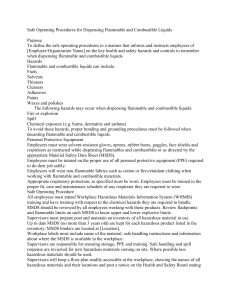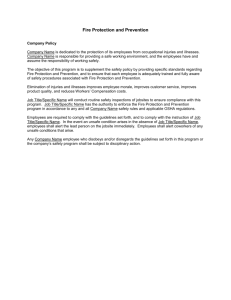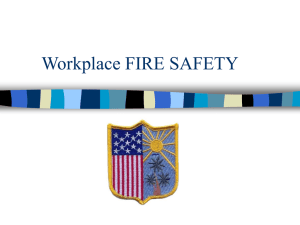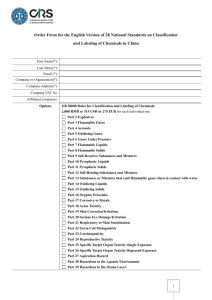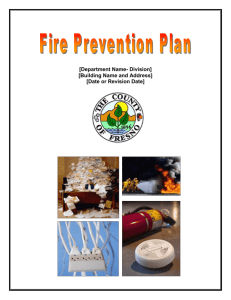Safe Storage and Handling of Flammable Goods
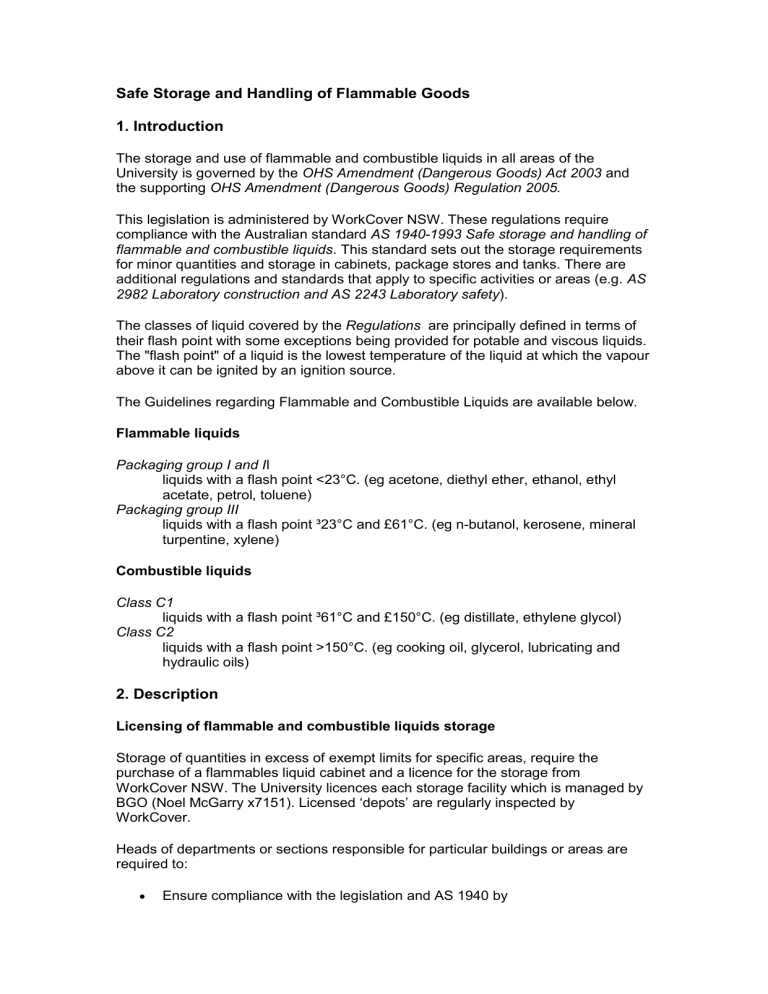
Safe Storage and Handling of Flammable Goods
1. Introduction
The storage and use of flammable and combustible liquids in all areas of the
University is governed by the OHS Amendment (Dangerous Goods) Act 2003 and the supporting OHS Amendment (Dangerous Goods) Regulation 2005.
This legislation is administered by WorkCover NSW. These regulations require compliance with the Australian standard AS 1940-1993 Safe storage and handling of flammable and combustible liquids . This standard sets out the storage requirements for minor quantities and storage in cabinets, package stores and tanks. There are additional regulations and standards that apply to specific activities or areas (e.g. AS
2982 Laboratory construction and AS 2243 Laboratory safety ).
The classes of liquid covered by the Regulations are principally defined in terms of their flash point with some exceptions being provided for potable and viscous liquids.
The "flash point" of a liquid is the lowest temperature of the liquid at which the vapour above it can be ignited by an ignition source.
The Guidelines regarding Flammable and Combustible Liquids are available below.
Flammable liquids
Packaging group I and I I liquids with a flash point <23°C. (eg acetone, diethyl ether, ethanol, ethyl acetate, petrol, toluene)
Packaging group III liquids with a flash point ³23°C and £61°C. (eg n-butanol, kerosene, mineral turpentine, xylene)
Combustible liquids
Class C1 liquids with a flash point ³61°C and £150°C. (eg distillate, ethylene glycol)
Class C2 liquids with a flash point >150°C. (eg cooking oil, glycerol, lubricating and hydraulic oils)
2. Description
Licensing of flammable and combustible liquids storage
Storage of quantities in excess of exempt limits for specific areas, require the purchase of a flammables liquid cabinet and a licence for the storage from
WorkCover NSW. The University licences each storage facility which is managed by
BGO (Noel McGarry x7151). Licensed ‘depots’ are regularly inspected by
WorkCover.
Heads of departments or sections responsible for particular buildings or areas are required to:
Ensure compliance with the legislation and AS 1940 by
o o o obtaining and maintaining any special storage facilities or equipment required, implementing necessary safe working procedures, and reporting to Noel McGarry, BGO, any significant difficulties or deficiencies with respect to the storage and handling of flammable or combustible liquids;
Limit quantities of flammable and combustible liquids to the lowest practical levels; and
Provide accurate details of inventory to BGO when required.
Minor quantities are defined for different occupancies in table 2.1 of AS 1940-1993
Safe storage and handling of flammable and combustible liquids .
3. Material safety data sheets (MSDS) and labels
3.1 Before using a flammable liquid, a copy of the MSDS should be obtained. A risk assessment should be undertaken based on a review of the MSDS and the intended use of the material. The control measures indicated by the risk assessment should be followed.
3.2 All containers of flammable and combustible liquids must be labelled with the following:
the name of the material, the appropriate risk and safety phrases, and for flammable liquids, the class label.
4. Storage of flammable and combustible liquids
4.1 Minor quantities of flammable and combustible liquids may be stored on open shelves or work benches. However, as storage in an enclosed space provides a high level of protection in the event of fire, it is recommended that the quantities stored in the open be kept to a minimum. Flammable and combustible liquids should not be stored on the floor.
4.2 The following minor quantities limits are provided for guidance
Offices 5 litres / floor (level)
Laboratories 10 litres / 50 m 2 floor area
Workshops 100 litres
4.3 Where the quantities stored exceed the minor quantities limits, flammable and combustible liquids must be stored in an approved flammable liquids cabinet.
Departments and sections requiring a flammable liquids cabinet should contact the
OH&S Unit for assistance.
4.4 The maximum quantity that may be stored in a flammable liquids cabinet is 250 litres. Departments should not keep quantities in excess of this limit. Where departments use significant volumes of flammable liquids, arrangements should be made for the purchase of these through the University Chemical Store (operated by the Department of Chemistry) which has a licensed facility for the bulk storage of solvents and chemicals, and resources for making deliveries to departments.
5. Safe working procedures for minor quantities
5.1 Where flammable liquids are kept on benches or shelves or in cupboards in quantities less than the limits set for minor quantities, the Australian standard AS
1940 requires the following minimum safe working procedures to be followed:
Flammable and combustible liquids must be stored away from ignition sources
(eg flames, electrical equipment, grinding and cutting operations) and excessively
hot locations
All containers must be kept closed when not in use (including containers for
waste liquids).
When carrying containers of flammable and combustible liquids care must be taken to minimise the possibility of spillage and fire. Properly designed carriers should be used for 'Winchester' sized containers (2 to 4 litres).
Any action to open or decant from a container of flammable liquid must be carried out in a well ventilated area and sufficiently distant from any potential ignition source so as to ensure safety having due regard to the quantity being handled.
Combustible wastes or residues must not be kept or left in areas where
flammable or combustible liquids are stored or decanted.
Materials that might interact dangerously with flammable and combustible liquids must be store separately from them. In particular oxidising agents must be stored separately.
All people handling flammable and combustible liquids must be familiar with their hazardous properties and the necessary safety procedures for handling them.
Any spillage must be cleaned up immediately.
The quantity of flammable and combustible liquids should be kept to a minimum.
In particular the number and size of containers kept on open benches or shelves should be kept as low as practical taking account of day-to-day requirements.
Special safety cans for flammable liquids may be purchased for areas where there is a high level of use.
Flammable and combustible liquids must not be stored or used where they may jeopardise escape from a room or building in the event of a fire.
Where the quantities of flammable liquids stored are greater than 100 litres: o A fire extinguisher appropriate to class B fires must be provided (dry o chemical or carbon dioxide).
A warning sign must be displayed.
6. Procedures for larger quantities
6.1 Where flammable and combustible liquids are used in larger quantities (ie quantities greater than minor quantities) the procedures outlined above should be followed together with the additional requirements set out in Australian standard AS
1940 for the quantities being used.
7. Waste flammable and combustible liquids
Waste flammable and combustible liquids are subject to the same requirements set out above - in particular the need to store 10 litre and 20 litre plastic drums within a flammable liquids cabinet. [Refer to separate guideline for the disposal of chemical waste.]
Flammables storage:
Flammable liquids are classified into ‘packaging groups’ (PG) depending on their flammability properties, this table defines the PG groups
Table 1: Packaging group allocation based on flammability
PG Flash Point
I -
II < 23ºC
III < or equal to 23ºC,
Boiling Point
> or equal to 35ºC
> 35ºC
> 35ºC
The quantities of flammable liquids that can be stored for day to day use in a lab are detailed in table 2, below.
Table 2: Day-to-day lab storage quantities of flammable liquids
PG I or II PG III
50L per 50m 2 of floor space 100L per 50m 2 of floor space
Storage Cabinets:
The maximum capacity of a flammable liquid storage cabinet is 250L
The cabinet must be constructed to Australian standards and
Have appropriate signage (see p16 below)
There must be no more than one cabinet per 250m 2 of lab floor space,
Cabinets must be a minimum of 5m apart, and
Be no less than 3m from an ignition source
They must not jeopardise the escape of people in the event of a fire and
There must be at least one 20B(E) powder extinguisher per indoor cabinet.

